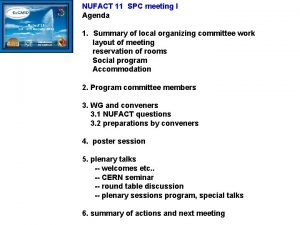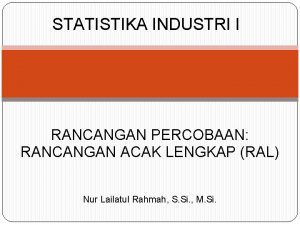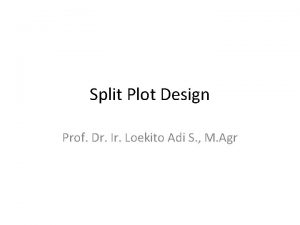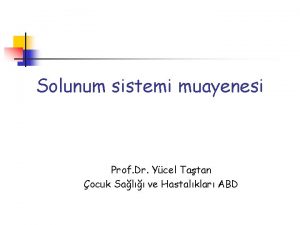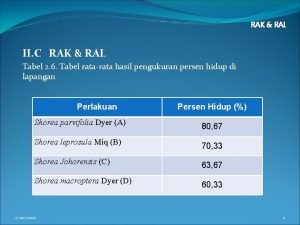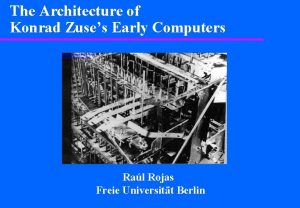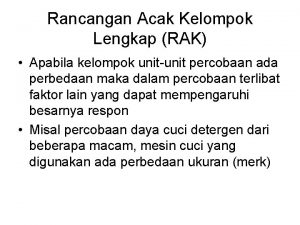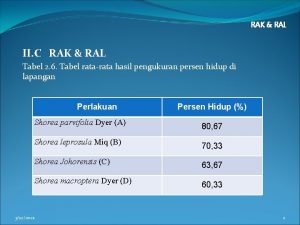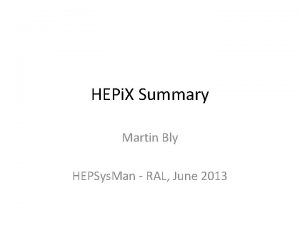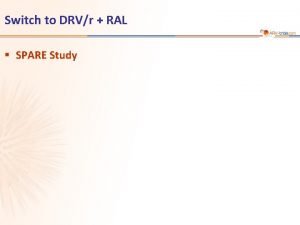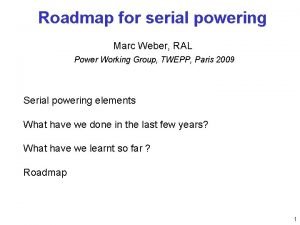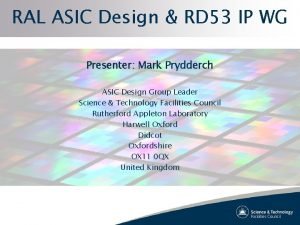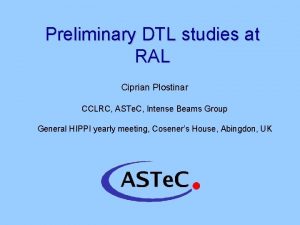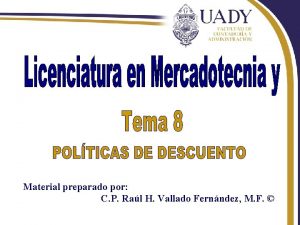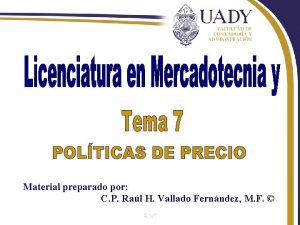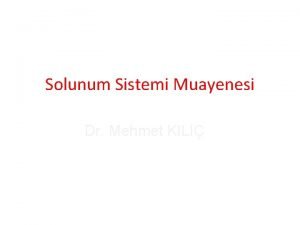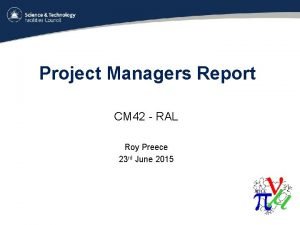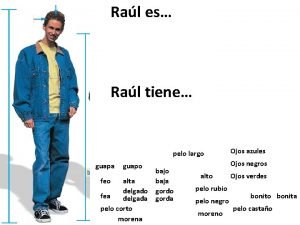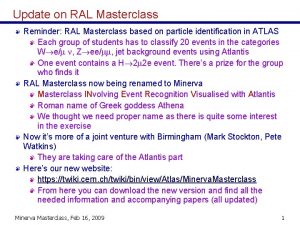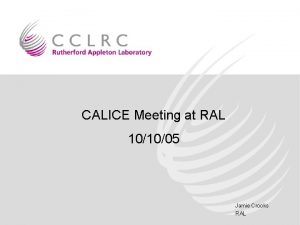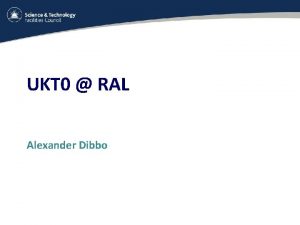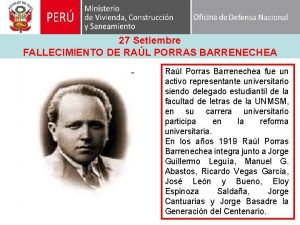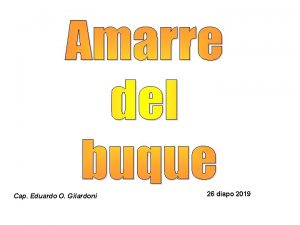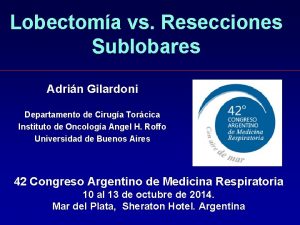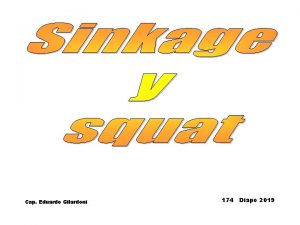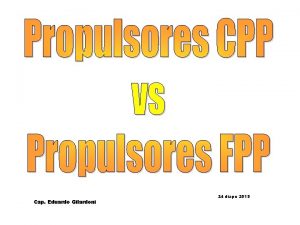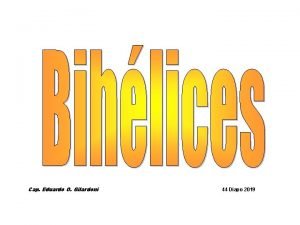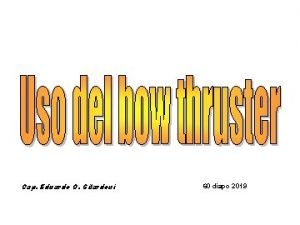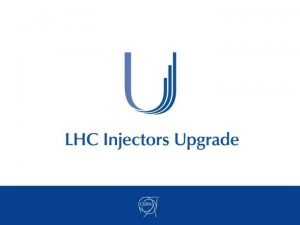Nufact RAL and CERN pdrivers S Gilardoni CERN


























- Slides: 26

Nufact RAL and CERN p-drivers S. Gilardoni – CERN Based on contributions from: J. Thomason, ISIS Accelerator Division M. Aiba, E. Benedetto, R. Garoby and M. Meddahi, CERN

Multi-MW p-driver Basic requirements: - 4 MW power on target Energy between 5 – 15 Ge. V RMS bunch length 1 – 3 ns 50 Hz rep. rate. 3 bunches, spaced by more than 80 μs

UK Green Field Solution

Chris Prior, Grahame Rees, Shinji Machida ( ) • Lower injection energies provide smaller bucket area in the ring and the small longitudinal emittance needed for final ns bunch compression. Studies show that 180 Me. V is a realistic energy for NF Proton Driver for a Neutrino Factory • Separate main ring with optics chosen for ns bunch compression. Could be FFAG (cheaper but insufficiently developed) or a synchrotron (reliable, tried and tested) • Special achromat for collimation (longitudinal and transverse) and momentum ramping for injection 10 Ge. V RCS • Separate booster ring designed for low loss phase space painting for beam injection and accumulation. Synchrotron moving buckets give flexibility to capture all of the injected beam • Compressed bunches need to be held and sent to target at intervals of ~100 μs. Possible in FFAG and also synchrotron with flat top

ISIS Upgrade + NF Solution

ISIS Upgrades • Present operations for two target stations Operational Intensities: 220 – 230 μA (185 k. W) Experimental Intensities of 3 1013 ppp (equiv. 240 μA) DHRF operating well: High Intensity & Low Loss Now looking at overall high intensity optimisation • Study ISIS upgrade scenarios 0) Linac and TS 1 refurbishment 1) Linac upgrade leading to ~0. 5 MW operations on TS 1 Overlap with NF 2) ~3. 3 Ge. V booster synchrotron: MW Target proton driver 3) 800 Me. V direct injections to booster synchrotron: 2 – 5 MW Target 4) Upgrade 3) + long pulse mode option

ISIS MW Upgrade Scenarios 1) Replace ISIS linac with a new ≈ 180 Me. V linac (≈ 0. 5 MW) 2) Based on a ≈ 3. 3 Ge. V RCS fed by bucket-to-bucket transfer from ISIS 800 Me. V synchrotron (1 MW, perhaps more) 3) RCS design also accommodates multi-turn charge exchange injection to facilitate a further upgrade path where the RCS is fed directly from an 800 Me. V linac (2 – 5 MW)

ISIS MW Upgrade Scenarios 1) Replace ISIS linac with a new ≈ 180 Me. V linac (≈ 0. 5 MW) 2) Based on a ≈ 3. 3 Ge. V RCS fed by bucket-to-bucket transfer from ISIS 800 Me. V synchrotron (1 MW, perhaps more) 3) RCS design also accommodates multi-turn charge exchange injection to facilitate a further upgrade path where the RCS is fed directly from an 800 Me. V linac (2 – 5 MW)

Possible ≈ 3. 3 Ge. V RCS Rings

5 SP RCS Ring Energy 0. 8 – 3. 2 Ge. V Rep Rate 50 Hz C , R/R 0 367. 6 m, 9/4 Gamma-T 7. 2 h 9 frf sweep 6. 1 -7. 1 MHz Peak Ksc ≈ 0. 1 B [ t] sinusoidal Peak Vrf ≈ 750 k. V εl per bunch ≈ 1. 5 e. V s

ISIS MW Upgrade Scenarios 1) Replace ISIS linac with a new ≈ 180 Me. V linac (≈ 0. 5 MW) 2) Based on a ≈ 3. 3 Ge. V RCS fed by bucket-to-bucket transfer from ISIS 800 Me. V synchrotron (1 MW, perhaps more) 3) RCS design also accommodates multi-turn charge exchange injection to facilitate a further upgrade path where the RCS is fed directly from an 800 Me. V linac (2 – 5 MW)

Grahame Rees, Ciprian Plostinar ( ) Ion Species Output Energy Accelerating Structures Frequency Beam Current Repetition Rate Pulse Length Duty Cycle Average Beam Power Total Linac Length 800 Me. V, Hˉ Linac Design Parameters H 800 Me. V DTL/SC Elliptical Cavities 324/648 MHz 43 m. A 30 Hz (Upgradeable to 50 ) 0. 75 ms 2. 25 % 0. 5 MW 243 m

Design Options

Common Proton Driver for the Neutron Source and the Neutrino Factory • Based on MW ISIS upgrade with 800 Me. V Linac and 3. 2 (≈ 3. 3) Ge. V RCS • Assumes a sharing of the beam power at 3. 2 Ge. V between the two facilities • Both facilities can have the same ion source, RFQ, chopper, linac, H− injection, accumulation and acceleration to 3. 2 Ge. V • Requires additional RCS machine in order to meet the power and energy needs of the Neutrino Factory • Options for the bunch compression to 1 – 3 ns RMS bunch length: - adiabatic compression in the RCS - ‘fast phase rotation’ in a dedicated compressor ring

Jaroslaw Pasternak, Leo Jenner ( , ) Preliminary design of the second RCS Parameters of 3. 2 – 9. 6 Ge. V RCS Number of superperiods Circumference Harmonic number RF frequency Gamma transition Beam power at 9. 6 Ge. V Injection energy Extraction energy Peak RF voltage per turn Repetition rate Max B field in dipoles Length of long drift • Present-day, cost-effective RCS technology • Only three quadrupole families • Allows a flexible choice of gamma transition • Up to 3. 7 MV/turn? 6 694. 352 m 17 7. 149 – 7. 311 MHz 13. 37 4 MW for 3 bunches 3. 2 Ge. V 9. 6 Ge. V ≈ 3. 7 MW 50 Hz 1. 2 T 14 m

SPL-Based NF Proton Driver Nearly Green Field Solution

Present LIU (2019) Back-up Proton flux / Beam power 50 Me. V Linac 2 Output energy 160 Me. V 1. 4 Ge. V 2. 0 Ge. V 4 Ge. V PSB 26 Ge. V 50 Ge. V PS 450 Ge. V 7 Te. V HP-SPL: Upgrade of infrastructure (cooling water, electricity, cryogenics etc. ) Linac 4 PSB LP-SPL PS LP-SPL: Low Power-Superconducting Proton Linac (4 Ge. V) PS 2 Replacement of klystron power supplies Addition of 5 high b cryomodules to accelerate up to 5 Ge. V Main requirements of PS 2 on its injector: SPS LHC / s. LHC Requirement Parameter Value 2. 2 x ultimate brightness with nominal emittances Injection energy 4 Ge. V Nb. of protons / cycle for LHC (180 bunches) 6. 7 × 1013 Nb. of protons / cycle for SPS fixed target 1. 1 × 1014 Single pulse filling of SPS for fixed target physics

SPL-Based Proton Driver: Principle • • Accumulation of beam from the High Power SPL in a fixed energy Accumulator (5 Ge. V, 4 MW beam power). Bunch compression ( «rotation» ) in a separate Compressor ring

SPL front end (Linac 4): block diagram Linac 4: 80 m, 18 klystrons 45 ke. V 3 Me. V H- RFQ CHOPPER RF volume source (DESY) 45 k. V Extrac. Radio Frequency Quadrupole 3 m 1 Klystron 550 k. W Chopper & Bunchers 3. 6 m 11 EMquad 3 cavities Ion current: 40 m. A (avg. ), 65 m. A (peak) DTL Drift Tube Linac 18. 7 m 3 tanks 3 klystrons 4. 7 MW 111 PMQs 50 Me. V CCDTL Cell-Coupled Drift Tube Linac 25 m 21 tanks 7 klystrons 7 MW 21 EMQuads 94 Me. V 160 Me. V PIMS Pi-Mode Structure 22 m 12 tanks 8 klystrons ~12 MW 12 EMQuads RF accelerating structures: 4 types (RFQ, DTL, CCDTL, PIMS) Frequency: 352. 2 MHz Duty cycle: 0. 1% phase 1 (Linac 4), 3 -4% phase 2 (SPL), (design: 10%)

Linac 4 building Oct 2010 Linac 4 Mar 2011 First user

HP-SPL: Main Characteristics Ion species Output Energy Bunch Frequency Repetition Rate High speed chopper (rise & fall times) H− 5 352. 2 50 <2 Required for low loss in accumulator Ge. V MHz Hz ns Required for muon production Required for flexibility and low loss in accumulator Option 1 Option 2 2. 5 or 5 2. 5 and 5 2. 25 MW (2. 5 Ge. V) or 4. 5 MW (5 Ge. V) 5 MW (2. 5 Ge. V) and 4 MW (5 Ge. V) Protons/pulse (x 1014) 1. 1 2 (2. 5 Ge. V) + 1 (5 Ge. V) Av. Pulse current (m. A) 20 40 Pulse duration (ms) 0. 9 1 (2. 5 Ge. V) + 0. 4 (5 Ge. V) Energy (Ge. V) Beam power (MW) 2 ´ beam current Þ 2 ´ nb. of klystrons etc.

110 m 0. 73 Ge. V 500 m 5 Ge. V Medium b cryomodule High b cryomodules Ejection 291 m 2. 5 Ge. V High b cryomodules 9 x 6 b=0. 65 cavities 11 x 8 b=1 cavities to EURISOL From Linac 4 0 m 0. 16 Ge. V 13 x 8 b=1 cavities Debunchers Segmented cryogenics / separate cryo-line / room temperature quadrupoles: -Medium b (0. 65) – 3 cavities / cryomodule -High b (1) – 8 cavities / cryomodule Low energy Intermediate energy High energy To HP-PS and/or Accumulator HP-SPL: Block Diagram

HP-SPL: R&D Objective Design, construction and test of a string of 4 b=1 cavities equipped with main couplers & tuners inside a “short” prototype cryo-module before the end of 2014 tested in 2014. Cryomodule (CERN – CNRS)

HP-SPL: Cavity & Cryomodule Design SPL b = 1 cavity + helium tank + tuner + main coupler Bulk niobium cavities (CERN) HOM coupler (CERN – Uni Rostock) Helium tank (CERN – CEA) Tuner (CEA) Main coupler (CERN)

Accumulator/compressor lattices from M. Aiba

HP-SPL: Cost Estimate (1/3/12) HP-SPL cost estimate - s. LHC-Project-Note-0037 (F. Gerigk, CERN-BE-RF, public) - Cost estimate : 806. 9 MCHF - Very detailed - Include services, tunnels, L 4 upgrade, even T-line to PS 2 - Does not include contingency - Does not include Linac 4 (~100 MCHF)
 Nufact
Nufact Fondeo barbas de gato
Fondeo barbas de gato Cloud ral
Cloud ral Contoh rancangan kegiatan statistik
Contoh rancangan kegiatan statistik Tabel anova split plot
Tabel anova split plot Parmak uçlarında çomaklaşma
Parmak uçlarında çomaklaşma Contoh soal rancangan acak lengkap pertanian
Contoh soal rancangan acak lengkap pertanian Tabel ral
Tabel ral Uji bnt ral faktorial
Uji bnt ral faktorial Ral computers
Ral computers Efisiensi relatif rak terhadap ral
Efisiensi relatif rak terhadap ral Ral tabel
Ral tabel Ral man
Ral man Ral 118
Ral 118 Ral weber
Ral weber Tabel ral
Tabel ral Ral tabel
Ral tabel Ral checker
Ral checker Ral medicina
Ral medicina Cp ral
Cp ral Cp ral
Cp ral Ral contreras
Ral contreras Ral
Ral Teknofest logo png
Teknofest logo png Ekspiryumda duyulan sesler
Ekspiryumda duyulan sesler Dr ral
Dr ral Ral project manager
Ral project manager
